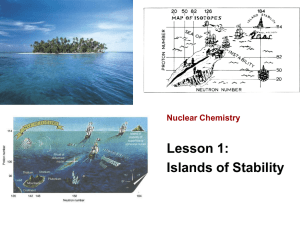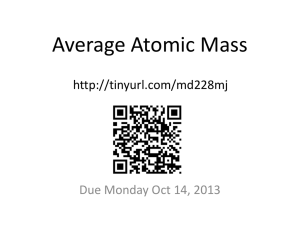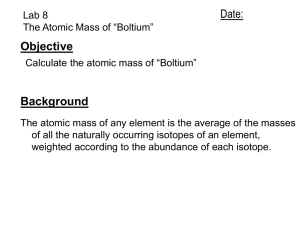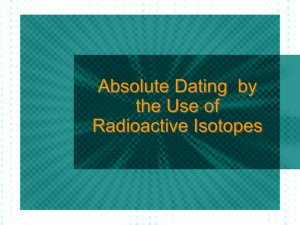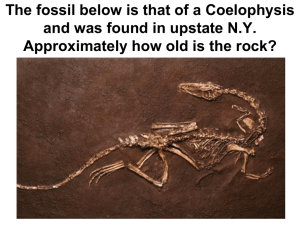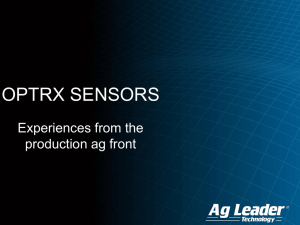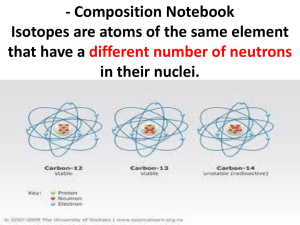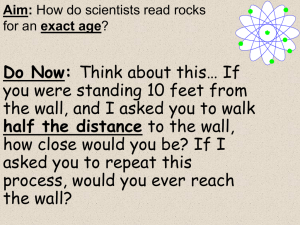Rabin-NuMass-20130206 - LTD for Neutrino Physics @ MiB
advertisement
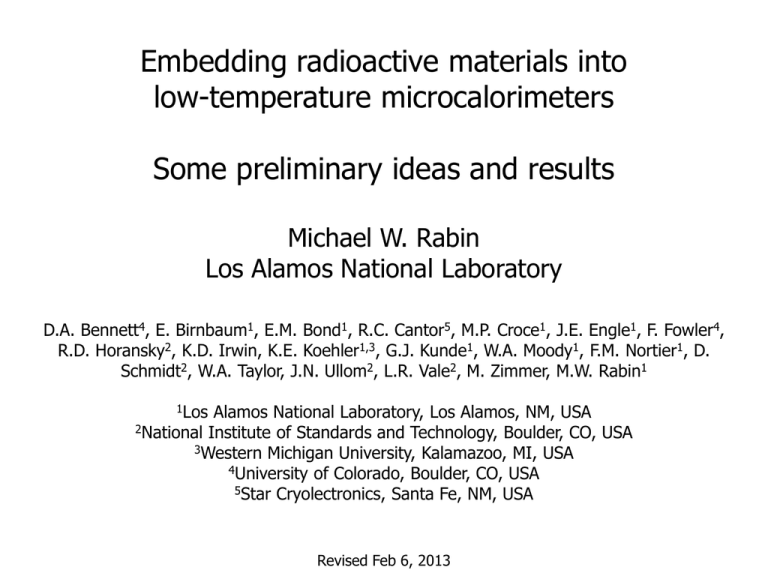
Embedding radioactive materials into
low-temperature microcalorimeters
Some preliminary ideas and results
Michael W. Rabin
Los Alamos National Laboratory
D.A. Bennett4, E. Birnbaum1, E.M. Bond1, R.C. Cantor5, M.P. Croce1, J.E. Engle1, F. Fowler4,
R.D. Horansky2, K.D. Irwin, K.E. Koehler1,3, G.J. Kunde1, W.A. Moody1, F.M. Nortier1, D.
Schmidt2, W.A. Taylor, J.N. Ullom2, L.R. Vale2, M. Zimmer, M.W. Rabin1
1Los
Alamos National Laboratory, Los Alamos, NM, USA
2National Institute of Standards and Technology, Boulder, CO, USA
3Western Michigan University, Kalamazoo, MI, USA
4University of Colorado, Boulder, CO, USA
5Star Cryolectronics, Santa Fe, NM, USA
Revised Feb 6, 2013
Energy resolution for X- and g-ray spectroscopy
Factor of ten better than conventional semiconductor technology
Close look at spectrum for X/g NDA of Pu
(98.95)
(102.98)
241Pu/
(99.85) (101.06)
(104.23)
(103.73)
Quantitative analysis of isotopic composition
Preliminary results from internal “round robin”— 3 sensors X 4 samples
Microcalorimeter
Conventional sensor
Atom ratio comparison for spectrum shown
Mcal 0.132 ± 0.006
TIMS 0.133 ± 0.003
External vs. internal for
a-decaying isotopes
Decay products are the alpha particle and the daughter atom
Q = Ea + ED
External source
External source
Internal
source
Internal
source
Energy
(keV)
Branch
Fraction
Q
5593
1
a
5499
5456
0.71
0.29
g
43.5
99.85
1 x 10-4
7 x 10-5
7
First high-resolution mixed actinide Q spec
Shows 3X increase in separation between peak centers
238Pu
241Am
8
Large microcalorimeter arrays for spectroscopy
+
Embedded radionuclides
+
Isotope production facility
Some radioactive decays of interest
a, b, electron capture
238
Pu ® 234 U + a
241
Am ® 237 Np + a
241
Pu ® 241 Am + e + n e
3
H ® 3 He + e + n e
187
Re ® 187 Os + e + n e
163
Ho ® 163 Dy * +n e
163
Ho ® 163 Dy + n e + {g , e, phonons}
10
Some radioactive decays of interest
a, b, electron capture
Also work by Loidl (CEA)
11
Some radioactive decays of interest
a, b, electron capture
Key linking science issue
The chemical form and physical
microstructure of the combination of
absorber and source affects energy
thermalization.
12
Some possible surrogate isotopes
Use for prototyping methods for isotope encapsulation and sensor designs
Parent
Gamma
rays?
Q
(keV)
isotope
half life
units
7Be
37Ar
53.28
35
day
day
y
n
41Ca
44Ti
49V
51Cr
53Mn
1.00E+05
52
337
27.7
3.70E+06
year
year
day
day
year
54Mn
55Fe
57Co
56Ni
67Ga
312
2.73
271.8
6
3.2
68Ge
71Ge
73As
72Se
270.8
11.4
80.3
8.5
Child
isotope
stable?
862
813
7Li
37Cl
y
y
n
y
n
y
n
421
268
602
751
596
41K
44Sc
49Ti
51V
53Cr
y
n
y
y
y
day
year
day
day
day
y
n
y
y
y
1377
231
836
2140
1001
54Cr
55Mn
57Fe
56Co
67Zn
y
y
y
n
y
day
day
day
day
n
n
y
y
110
233
340
330
68Ga
71Ga
73Ge
72As
n
y*
y
n
Isotopes that decay solely by electron capture to the nuclear ground
state of a very long lived or stable product (child) isotope.
High Q is OK for prototyping.
Screening is incomplete and not yet detailed enough.
13
Possible methods of deposition and encapsulation
Assuming you start with liquid water-based solution of radioactive material
•
Drying of water-based solution
•
Electrodeposition
•
Metalurgy
•
Surface chemistry
you get everything that does not evaporate
coffee-ring effect
mitigated by extremely very small volumes, ~10 picoliter
more selective
codeposition of major species (e.g. Cu, Au, Bi) and ultra trace (Fe, Ho)
used for Cu vias in zillions of integrated circuits
unfavorable phase diagrams
rapid freezing from melt common to quench nonequilibrium concentration
bonding and diffusion techniques based interface metalurgy (eutectics)
controlled atmosphere, temperature, time, substrate
chemical reduction of salts and oxides hard
selective binding to surface with custom ligands
14
Incorporation of aqueous source and encapsulation
Techniques for analytical picoliter dispensing under development by LANL-HP
collaboration
Precise control of dispensed volume, droplet position, and final spot size
Mitigates position-dependent response of sensors
Allows us to control activity per sensor
Control of physical form and chemical composition will affect energy
thermalization physics in the sensors
Examples from
55Fe
electrodeposition
16
Recent sensors for ECS of
55Fe
17
Spectral results ECS of
commercial
55Fe
55Fe
Taylor-made
55Fe
larger absorber
Taylor-made
55Fe
smaller absorber
~54 eV FWHM
18
Improved spectral results ECS of
55Fe
19 eV
s = 5.25 eV
2.35 s = 12.4 eV
l1 = 8.9 eV
l2 = 47 eV
h = 0.37
19
New sensors designs
No membrane. Easier to make. More robust.
20
Concluding remarks
This is the era for wide-ranging experimentation in for embedding
radioactive isotopes into sensors.
Long-range plans for calorimetric spectroscopy for neutrino mass
call for
DE = 1-2 eV FWHM
A = 1-100 Bq per pixel
which have been not yet been shown for any EC-decaying isotope.
By prototyping with 55Fe, then 163Ho we mean to try.
Large high-resolution arrays + embedded radioisotopes + isotope production
21
X
g a
Q b
e
EC
X
g a
Q b
e
Calorimetric electron capture energy spectroscopy combines
many of these.
24

